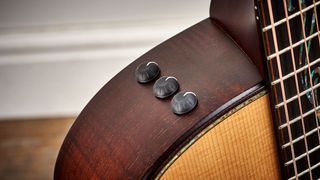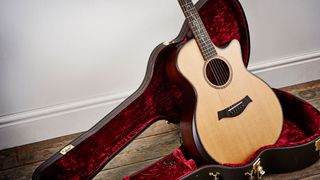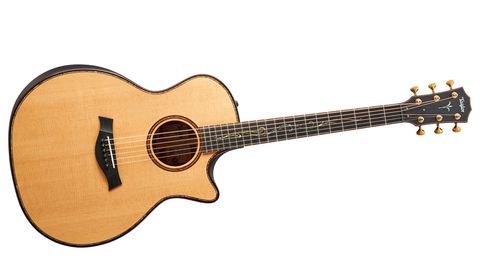Over the past four decades Taylor has re-engineered the acoustic and electro acoustic guitar to a level that’s unsurpassed in the mainstream acoustic world.
Finding a new way has been a mantra for the company, which has been evident from the earliest Taylors (renowned for their easy, almost electric-like playability) through to the new neck- design, state-of-the-art production methods, robotic spraying, proprietary electronics... on it goes.
When Bob Taylor handed over the baton to Andy Powers (who joined Taylor in 2011), he quickly made his guitar-making and playing experience noticeable with a new Grand Orchestra model, the re-voicing of the 800 and 600 series, not to mention the 12-fret Grand Concert (including the very playable 12-string). He then turned his vision to the start-up Academy series and even threw in an engaging GS Mini electro acoustic bass.
Initially, some believed his extensive building experience brought a more classic vintage-informed style to temper the modernism of the prior Taylor designs. If he has done that, however, 2018 is a turning point that starts with the simple question: how do you make the world’s most successful guitar brand even better? With a new bracing design called V-Class, that’s how.
While we relate the thinking behind V-Class elsewhere in this feature, the Builder’s Edition V-Class K14ce - one of four new 2018 V-Class launches that also include a K24ce, 914ce and PS14c - it’s quite a statement of intent.

It combines the new bracing with a notably different, more comfortable, Grand Auditorium style. Of course, its build-quality is nothing short of exceptional as we’d expect, and not least at this price.
Like PRS in the electric world, Taylor has raised the bar in terms of what we expect from a high-quality production maker. That latter point is important. Taylor makes a lot of guitars (around 600 per day), and production efficiency and consistency is key. For many, the modernist opulence of the higher level series guitars is at odds with the ‘blue collar’ classic vision of, most obviously, Martin.
To some extent this new Builder’s Edition model, visually at least, retains some ‘posh’, but pares that back with not only its darkened and torrefied Sitka spruce top, but the ‘silent’ satin finish - the antithesis of the finely buffed, mirror sheen of the majority of Taylor’s guitars.
The aesthetic is altered by the edge ‘binding’, which isn’t actually binding at all. Instead the koa of the sides forms the top edge, which is noticeably chamfered. The inner purfling is koa, then there’s an inset line of paua shell with thin lighter wood either side, and finally a black line butted up against the top wood. The comfort that this edge chamfering brings is enhanced by the armrest; plus, we also have an angled scoop inside the treble cutaway, all adding to a more comfortable, ergonomic feel and appearance.
Dimensionally, this K14ce is slightly more tapered depth-wise than the 914ce we used for comparison. Subtle, yes, but it all contributes to the impression that this Builder’s Edition is more compact both in appearance and feel than a regular Taylor GA.
A quick identifier, by the way, for the V-Class-braced models is the black graphite-loaded nut (along with a new label that for the first time features Andy Powers’ signature), as opposed to the cream-coloured Tusq that is standard on the non-V-Class models.

We’re reminded of the K14ce’s high-end lineage, however, by the paua ‘spring vine’ inlay that lies down the majority of the black/dark brown ebony ’board, while a lighter koa purfling stripe sits just inside the ebony edge-binding and continues around the headstock, which is again ebony-faced with a relatively demure paua inlay. The aged-gold Gotoh tuners perfectly fit the slightly worn-in vibe - hugely understated class, just like the green abalone dots in the ebony bridge-pins.
While there’s plenty for those who love details to admire, the modern Taylor guitar is hugely sorted in terms of playing feel. Frets are immaculately installed, string height is set to approximately 1.8mm on the treble side and 2.2mm on the bass
side, when measured at the 12th fret.
It’s extremely electric like. Nut width falls on the wider of Taylor’s sizes and comes with an airy string spacing of 38mm that widens out to 56mm at the bridge. The quality electric-like feel is supported by the neck shape with a subtle hint of a V making it feel thinner to the hand than its barely tapering depth - 21.3mm at the 1st, 22.3mm by the 10th fret before the boat-bowed heel - actually suggests. It’s a neck shape you just don’t notice, and that’s a huge compliment.
Standard equipment is evident in the Expression System 2, the bridge transducer elements, with three ‘response’ adjustment Allen key bolts, sitting behind the heavily compensated and shaped Micarta saddle. As ever, centre-notched volume, treble and bass controls with their low-profile ribbed rubber knobs sit on the upper shoulder.
The output jack doubles as the lower strap button (placed with an oval recessed split plate that also allows easy replacement of the 9V block battery via a clip on/off cover), although, unusually, the upper strap button is placed on the back of the body just below the heel as opposed to the usual position on the treble side of the heel which, for upper fret work, can get in the way. This placement, along with that scoop in the cutaway, suggests increased access as well as comfort was another subtle part of the instrument’s design.
Feel & Sound
There’s little doubt you can disappear down a big ol’ rabbit hole trying to evaluate the often-subtle sound differences between acoustic guitars, especially at this level. Quite often it’s a style and aesthetic that’ll sway you; other times it’s purely the voice.
With a pair of identical 914ces - one with standard bracing, the other with V-class - and this Builder’s Edition, we had plenty to listen to. Each guitar definitely has its own character. Bracing aside, we have the koa back and sides of the K14ce compared to the more conventional voice of rosewood on the 914ce duo. And ‘conventional’ is a pretty good description of Taylor’s GA with pristine highs, generous piano-like lows and a lightly scooped midrange that sounds extremely - in a good way - contemporary and quite the all-rounder.
Taylor states that koa does need playing in before it achieves its maximum potential, and that ties in with the initial impression of the K14ce - it does sound a little ‘tight’ compared to the ‘looser’ 914ces. Yet it brings exceptional balance to the guitar that would certainly aid a recording musician, not least one that has to compete in an ensemble setting. But the more we play the more we uncover...
There’s a sonorous piano-like response right across the range that makes more complex chord voicing sound beautifully in tune
It’s quite a chameleon stylistically, so jazzier and bluesier styles suit just as well as Latin bossa where the thumbed bass-lines sit perfectly below those jazzy chord inversions - there’s certainly a little ‘nylon’ to the sound in terms of a strong fundamental. But then open tune and slip on a bottleneck and you’d swear you were playing a smaller body guitar.
As you dig in, you get it back - it’s extremely dynamic. And again it’s got power in the higher registers that make leads strong either from your fingers or a pick. There’s a hint of an archtop too. Again, play in that big-band chop-strummed style and you’d swear you were back in the 40s. But then re-tune to DADGAD and the guitar sounds so in tune and evocative that you could sit right down and start writing your next solo fingerstyle piece.
There’s a sonorous piano-like response right across the range that makes more complex chord voicing sound beautifully in tune. We can’t remember having intonation issues with any Taylor guitar but there’s a smoothness and purity here that allows exceptional chordal range without any angry intervals.
The access afforded by the cutaway and that scoop actually means, not least with the perfect-sounding intonation, that high-position leads work and high-position chording does too.
Those less-sharp edges and armrest play their part in making this Builder’s Edition feel like an old pair of shoes - the aged patina of those excellent tuners also add to the vintage vibe - and suddenly any thought of this being the new state-of-the-art release from the state-of-the-art makers disappears, and the guitar begins to feel and sound like the best vintage instrument you dream of owning (but without any of the issues of an old guitar).
Taylor’s ES2 pickup system might only offer treble, bass and volume controls, but it’s far from difficult to dial in a credible sound that really mirrors what we hear acoustically. But again swapping between the X-braced 914ce, the new V-class version, and our K14ce we hear virtually identical attributes in the V-Class guitars - a cleaner lower midrange and that almost other-worldly in-tuneness that’s so noticeable in higher registers, whereas the X-braced 914ce, by comparison, now seems ever so slightly ‘out’.
Back on the K14ce, the subtly more balanced voice dips in and out of different styles and genres so easily. We’d strongly suggest jazz players will be drawn to this blank canvas and even that cutaway scoop just makes high position, especially chords, that little bit more comfortable to your left-hand. Again, that intonation purity makes probably more impression on your ears.
Exactly what the V-Class bracing is doing we only have these guitars to go on and as our studio test confirms both the new-braced guitars have a little more ‘everything’to them. While the 914ce V-Class is perhaps the most obvious in terms of its richer, fuller voice that, put simply, sounds enhanced compared to its standard-braced identical twin, the Builder’s Edition, which pulls back a little on the bluster yet almost offers a smoother, hint of a semi-hollow, response that makes high-fret work fuller and stronger sounding.
For the diehard ‘acoustic’ player we’d suggest the V-Class 914ce would be the choice with its more conventional steel string response, not to mention appearance. However, the K14ce is our choice for the player crossing styles and genres especially using more complex harmonies, even though the subtly muted highs we hear actually make it our preference for more standard rhythm beds too.
V-Class, Builder’s Edition? Get used to those terms. Taylor has just upped the ante. Considerably.


